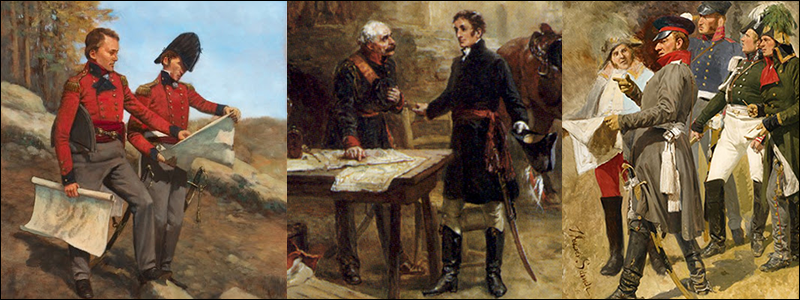|
Allied Training College (ATC) Coalition Library |
Melee Calculations |
Gentlemen, welcome to the Melee Calculations Course. As some of you already know melee results don’t simply pop up as the computers feels fit but are based on a Melee Table that can be found in the Parameter Data sheet which is a part of the Scenario Notes that come with every Battleground game. The melee table is composed of nine lines and twelve columns. Lines representing the odds which are the ratio between the respective numbers of attackers and defenders. The nominal attack value for infantry or cavalry is its strength divided by 25 and the nominal defend value of artillery units is its strength (number of guns). There are several modifiers that are applied to the strength values for both defending and attacking units. These strength modifiers are applied to defending units:
These modifiers are applied to attacking units:
Quality modifiers apply in both attack and defense:
Columns represent various dice throws (from 1 to 12) which are based on laws of probability. There is a group of modifiers that affect the minimal possible dice throw:
Here is the procedure for determining the required strength of attacking force:
Example 1: 2 enemy battalions with a leader deployed in an open terrain, one 2xx, other 6xx men. This makes 900 men for our calculation purposes. You can hit them in the flank (+2) with you cavalry (+1), and a leader (+1) but you have to attack uphill (-1) and they also have a leader (-1). This makes a total of +2 meaning the lowest possible dice throw of 3. You take a look at the melee table and see that you have to attack with 3:1 odds in order to have a 100% chance of wining a melee with a dice throw of 3. With cavalry 100% chance is usually what you want as they’re worth too much to be used in indecisive actions. This means you have to attack with 900 cavalry (they’re worth 2700 men for calculations purposes as they get 3x bonus). If you use 500 men lancer regiment (25% increase of number for a total of 625 men) you only need 275 more chasseurs and you’re certain that you’ll destroy two enemy infantry regiments. Example 2: 3 enemy battalions with a leader, deployed in an open terrain, one 2xx, other two 3xx men. This makes 950 men for our calculation purposes. You can’t hit them in the flank, you will hold your fire (+1) and attack with a leader (+1) and they also have a leader (-1) This makes a total of +1 meaning the lowest possible dice throw of 2. You take a look at the melee table and see that you have to attack with 4:1 odds in order to have a 100% chance of wining a melee but you’ll get more than 75% chance of wining with 2:1 odds which is still acceptable for infantry attack. This means you’ll have to attack with 1900. If you manage to get 1525 men in column formations you have enough and you can attack the enemy with a solid chance of wining. You must not forget that you opponent has a defensive fire phase in which he can shatter your carefully prepared attack but that’s a chance you’ll have to accept and always had a little more men ready than needed. I hope you find this information useful and that you’ll implement this theory in your battles. Class dismissed! [Written by Dejan Zupancic]
|
Site Designed Maintained by Scott Ludwig & Walt Moehle (Coalition Army Webmasters) © 2005-Present September 28, 2024 12:29 PM |
